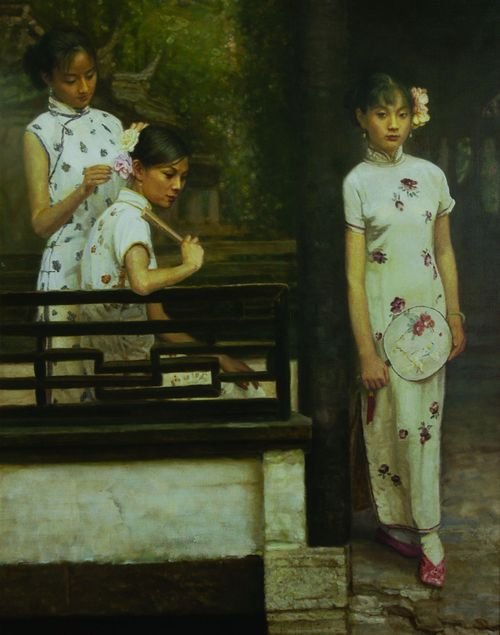Chinese Art
dal 19/11/2007 al 5/1/2008
Segnalato da
Institut Valencia' d'Art Modern
Shen Yong
Jiang Jianzhong
Yu Xiaofu
Chen Yiming
Wang Jieyin
Ding Lipin
Ju Yan
Li Zhaohua
Mou Huan
Jian Baohong
Fu Ming
Son Kexi
Xu Xuechu
Gu Zhongxiang
Huang Azhong
Yang Jianzhong
Gerardo Rueda
19/11/2007
Chinese Art
IVAM Instituto Valenciano de Arte Moderno, Valencia
Shangai International Culture Association

Curator Yang Jianzhong
As the result of the agreement signed between the IVAM and the
Shanghai International Culture Association, the exhibition brings toghether 69
works by the artists: Shen Yong, Jiang Jianzhong, Yu Xiaofu, Chen Yiming,
Wang Jieyin, Ding Lipin, Ju Yan, Li Zhaohua, Mou Huan, Jian Baohong, Fu
Ming, Son Kexi, Xu Xuechu, Gu Zhongxiang, and Huang Azhong, all
representing the backbone of Chinese oil painting. The exhibition seeks to show
the Spanish audience the virtual spirit of Oriental art as well as the uniqueness
and aesthetic force of Chinese pictorial language. The different styles featured
allow to appreciate the evolution of Chinese art after the appearance of a new
generation of artists embracing Western artistic innovations and questioning the
sense of authority and tradition. The catalogue published on occasion of the
show contains the works exhibited and includes texts by Zheng Jiayao, Director
of the Shanghai International Culture Association; Yu Xiaofu, artist and
Vicepresident of the Shanghai Oil Painting & Sculpture Institute; Maria Cruz
Alonso Antolín, Director of the Asia-Pacific SGAE (similar to the ASCAP -
Association of Composers, Authors and Publishers); Yang Jianzhong, artist and
curator of the exhibition; and Consuelo Císcar, Director of the IVAM.
Systematic Modernity in China did not take place until lates 80’s of the 20th
century. Changes taking place during last years —opening and politic,
economic, and cultural reforms— have fundamentally influenced the sphere of
art, in which oil painting has been representative of its permeability towards
Western movements. But the discussion comparing the cultural differences
between East and West has its origin in the 17th century, when Chinese painters
began to consider the Western ideas on pictorial representation related to
geometry, three-dimensional forms and treatment of matter. It must be taken
into account the fact that traditional Chinese painting came into being as an
independent branch of calligraphy and took its foundation from the four
treasures of writing: paintbrushes, ink, inkwell, and rice paper. The main
element of Chinese painting is line, a feature also characterizing calligraphy,
what has involved that both arts have been closely related since their origins.
The expansion of the political and economic imperialism of Western powers in
the late years of the 19th century brought about a small cultural revolution in
China, where an intellectual elite appropriated a series of models from Western
culture —such as oil painting— and used them to revise and revive their fragile
traditions, which had been strongly shaked by West hegemony. This selfprotection
project evolved until in the year 1949 Communist Party took the
power in Continental China, starting then the Cultural Revolution lasting up to
late 70’s. By that moment, there was a reorientation towards an ideological art
which, made for masses, displayed a nationalist flavour and was based on an
iconoclastic philosophy both anti-traditional and anti-Western. Social Realism
imitating the Soviet one became a first-rate political instrument and a training
doctrine in art schools.
In 1976, after Mao Zedong’s death and the end of the Cultural Revolution, the
opening of borders towards the West brought about the appearance of a new
generation of artists embracing Western artistic innovations, criticizing the
sense of authority and questioning tradition. This generation was called ’85
Movement and gathered unofficial artist groups suffering a continuous evolution
both in art concepts and techniques. Humanism, Rationalism, political Pop,
Kitsch Art, Realism, Conceptual Art, etc., are some of the movements
developed during the last 20 years.
-----
15th November 2007 – 20th January 2008
Centro Julio Gonzalez - Galería 7A (Abajo) y Galería 7B (Arriba)
Gerardo Rueda
The exhibition The Imaginary Museum shows 455 pieces from the artist's private collection, consisting of both art works and diverse objects acquired in flea markets and antique shops. The wide variety and number of pieces composing Rueda's collection make difficult to draw a map of the "imaginary museum". It is outstanding the coexistence of a very wide set of antique objects (313 pieces) exhibited at the Museo de la Ciudad de Valencia, along with a Spanish contemporary art collection shown at the IVAM (142 pieces) including works by Fernando Zobel, Gustavo Torner, Carmen Laffon, Jose' Guerrero, Eusebio Sempere, Alvaro Feito, Manuel Millares, Antonio Saura, Pablo Palazuelo, and Jorge Teixidor, among others, as well as drawings by Solana, Julio Gonzalez, Vazquez Díaz, Benjamin Palencia, Antonio Lopez, and Esteban Vicente.
Image: Chen Yiming
IVAM Institut Valencià d’Art Modern
Guillem de Castro, 118
46003 Valencia



